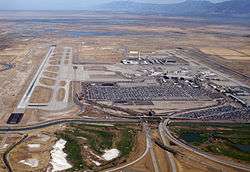Salt Lake City International Airport
| Salt Lake City International Airport | |||||||||||||||||||||||
|---|---|---|---|---|---|---|---|---|---|---|---|---|---|---|---|---|---|---|---|---|---|---|---|
 | |||||||||||||||||||||||
|
Salt Lake City airport in 2010 | |||||||||||||||||||||||
|
IATA: SLC – ICAO: KSLC – FAA LID: SLC – WMO: 72572 | |||||||||||||||||||||||
| Summary | |||||||||||||||||||||||
| Airport type | Public | ||||||||||||||||||||||
| Owner | Salt Lake City | ||||||||||||||||||||||
| Operator | Salt Lake City Department of Airports | ||||||||||||||||||||||
| Serves | Northern Utah area and beyond | ||||||||||||||||||||||
| Location |
Salt Lake City, Utah | ||||||||||||||||||||||
| Hub for | Delta Air Lines | ||||||||||||||||||||||
| Elevation AMSL | 4,227 ft / 1,288 m | ||||||||||||||||||||||
| Coordinates | 40°47′18″N 111°58′40″W / 40.78833°N 111.97778°WCoordinates: 40°47′18″N 111°58′40″W / 40.78833°N 111.97778°W | ||||||||||||||||||||||
| Website | slcairport.com | ||||||||||||||||||||||
| Maps | |||||||||||||||||||||||
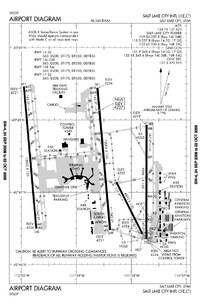 FAA airport diagram | |||||||||||||||||||||||
 SLC  SLC Location of airport in Utah/United States | |||||||||||||||||||||||
| Runways | |||||||||||||||||||||||
| |||||||||||||||||||||||
| Helipads | |||||||||||||||||||||||
| |||||||||||||||||||||||
| Statistics (2015) | |||||||||||||||||||||||
| |||||||||||||||||||||||
Salt Lake City International Airport (IATA: SLC, ICAO: KSLC, FAA LID: SLC) is a civil-military airport about 4 miles (6.4 km) west of Downtown Salt Lake City, Utah, United States. The airport is the closest commercial airport for more than 2.5 million people[4] and is within a 30-minute drive of nearly 1.3 million jobs.[5]
The airport is the fourth-largest hub for Delta Air Lines, as well as a hub for Delta Connection carrier SkyWest Airlines with nearly 300 daily departures, accounting for a 72.39% market share between October 2014 and September 2015. Following Delta and Delta Connection, the largest carriers are Southwest Airlines (11.11% market share), American Airlines (3.43%), and Alaska Airlines (2.56%).[6]
In 2015, 22,141,610 passengers flew through Salt Lake City, representing a 5% increase from 2014. The airport is the twenty-first busiest airport in the United States by passenger count.[7] There were 324,955 aircraft operations (takeoffs and landings) in 2014, about 900 per day. The airport is the fifteenth busiest airport in the United States and twenty-fourth in the world by operations.[8]
As of April 2013 there were over 645 scheduled nonstop airline departures and arrivals per day to 89 cities in the United States, Canada, Mexico, and Europe.[9]
Salt Lake City International Airport continues to rank high for on-time departures/arrivals and fewest flight cancellations among major US airports. The airport ranked first for on time departures and arrivals and second for percentage of cancellations as of September 2014.[7]
The airport is owned by Salt Lake City Corporation and is administered by the Salt Lake City Department of Airports. The city owns and operates two nearby airports, South Valley Regional Airport and Tooele Valley Airport.[10] The airport is financially self-sustaining with revenue generated from airline and passenger fees, concessions, vehicle parking, fuel, and leases for office and hangar space. It is the only major airport in the country with no outstanding debt.[11]
History
In 1911 a site for an air field was chosen on Basque Flats, named for Spanish-French sheep herders who worked the fields in the then-desolate area of the Salt Lake Valley. A cinder-covered landing strip was created, far better than the small fields at the Utah State Fairpark which had previously been used. The Great International Aviation Carnival was held the same year and brought aviation pioneers representing Curtiss Aeroplane and Motor Company and a team representing the Wright Brothers to Salt Lake City. World-famous aviator Glenn H. Curtiss brought his newly invented Seaplane to the carnival, a type of airplane which had never been demonstrated to the public before. Curtiss took off from the nearby Great Salt Lake, awing the 20,000 spectators and making international headlines.[12]
For several years the new field was used mainly for training and aerobatic flights. That would change in 1920 when the United States Postal Service (USPS) began air mail service to Salt Lake City. The airport expanded and hangars and other buildings began to appear. In the same year, the airfield was given the name Woodward Field, named for John P. Woodward, a local aviator.[13]
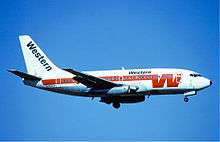
In 1925 the postal service began awarding contracts to private companies. Western Air Express, the first private company to carry U.S. mail, began flying from Salt Lake City to Los Angeles via Las Vegas. Less than a year later Western Air Express would begin flying passengers along the same route. Western Air Express later became Western Airlines, which had a large hub in Salt Lake City.[13]
Charles Lindbergh visited Woodward Field in 1927 drawing many spectators to see The Spirit of St. Louis. During the next few years the airport would gain another runway and would span over 400 acres (1.6 km2). In 1930 the airport was renamed Salt Lake City Municipal Airport.[14]
The first terminal and airport administration building was built in 1933 at a cost of $52,000. By then United Airlines had begun serving Salt Lake City on flights between New York City and San Francisco.[14][15]

.
As air travel became more popular and the United States Air Force established a base at the airport during World War II, a third runway was added (Runway diagram for 1955). The April 1957 OAG (formerly the Official Airline Guide) shows 42 weekday departures: 18 on Western, 17 United and 7 Frontier. United had flown nonstop to Chicago since 1950, but a New York nonstop didn't start until 1968. The first jets were United 720s in September 1960.
A new terminal was needed and work began on the west side of the airport on Terminal 1, designed by Brazier Montmorency Hayes & Talbot and dedicated in 1960 after seven years of work and a cost of $8 million.[16] In 1968 the airport became Salt Lake City International Airport[17] when a non-stop route to Calgary, Canada was awarded to Western Airlines.
After airline deregulation in 1978, hub airports appeared. Western Airlines, with ties to Salt Lake City since its inception, chose the airport as one of its hubs. Terminal 2 was designed by Montmorency Hayes & Talbot and built solely for Western and had several murals by artist LeConte Stewart.[18]
During the 1980s the airport saw further expansion to both terminals as well as runway extension. In 1987 Western Airlines merged with Delta Air Lines. Salt Lake City would continue to be a major airline hub.
In 1991 the airport opened a new short-term parking garage. The airport opened a new runway in 1995 along with the International Terminal and E concourse for SkyWest Airlines, which was designed by Gensler.[19] A new 328-foot-tall (100 m) control tower, new approach control facility, and a new fire station were opened in 1999.[14]
In 2001, Concourse E was expanded for additional gates and SkyWest Airlines opened its new maintenance hangar and training facility. In 2002, the airport saw heavy crowds as Salt Lake City welcomed over one million visitors for the Winter Olympics.
Recently the airport has upgraded its access roads and parking facilities in preparation for a new terminal. The airport has made minor upgrades to the terminals and concourses including expansion of baggage claim facilities.[20]
Three days after the Paris terror attacks, an Air France A380 traveling from Los Angeles, California to Paris, France was diverted to Salt Lake City International Airport due to a bomb threat on the aircraft.[21] The aircraft was the largest plane to ever land at the airport. The airport workers had only 15 minutes to get ready for the emergency landing.
International service
Delta Air Lines, the airport's leading carrier has scheduled flights to cities in Canada, Mexico, France, The Netherlands and The United Kingdom.
On May 28, 2016, Air Canada began daily nonstop service to Toronto–Pearson from Salt Lake City.[22] Air Canada Express had previously operated service to Toronto from 2006 through 2007.
Aeroméxico offered service from Salt Lake City to Hermosillo and Mexico City from 2002 through 2005. In November 2008, Aeroméxico resumed nonstop service to Mexico City though service was once again discontinued.
In June 2008, Delta Air Lines began daily nonstop service to Paris–Charles de Gaulle. This marked the first scheduled transatlantic route from Salt Lake City. In November 2008, Delta announced nonstop service to Narita International Airport near Tokyo, Japan, mostly as a result of Delta's merger with Northwest Airlines. The service began on June 3, 2009,[23] the first nonstop from Salt Lake City to Asia. In 2010–2011 the flights to Tokyo were seasonal, May to October.[24] Delta has not operated the flight since October 2011.
Delta Air Lines launched seasonal nonstop service to Amsterdam Airport Schiphol in May 2015, which was increased to daily service in late March 2016. In addition to Paris and Amsterdam, Delta launched a third transatlantic nonstop route from Salt Lake City to London–Heathrow on April 23, 2016.[25] Other recent international routes that Delta Air Lines has launched from Salt Lake City include nonstop service to Mexico City which was resumed in December 2014, and daily nonstop service to Toronto–Pearson which was resumed in May 2016. These international additions are a direct result of Delta's renewed 10-year lease at the airport and commitment to expand at SLC.[26][27]
On May 5, 2016 KLM began new, twice weekly nonstop service from Salt Lake City to Amsterdam, and increased service to three times weekly on July 4, 2016. It is the first transatlantic route from Salt Lake City served by a European-based airline. The service is intended to supplement the existing daily flight between Salt Lake City and Amsterdam operated by Air France KLM’s Transatlantic Joint Venture partner Delta Air Lines.[28]
Terminals
Three passenger terminals have five concourses with a total of 83 gates:
- Terminal 1 has Concourse A (gates A1-A9) and Concourse B (gates B1-B22).
- Terminal 2 has Concourse C (gates C1-C13).
- International Terminal has Concourse D (gates D1-D13) and Concourse E (gates E60-E85).[29] However, arriving international flights only use gates D2, D4, and D6 in Concourse D.
Airlines and destinations
Passenger
Cargo
| Airlines | Destinations |
|---|---|
| Ameriflight | Boise, Burley, Cedar City, Elko, Ely, Idaho Falls, Jackson Hole, Logan, Pocatello, Rexburg, Rock Springs, St. George (UT), Sun Valley, Twin Falls, Vernal |
| DHL Aviation operated by ABX Air | Cincinnati |
| DHL Aviation operated by Air Transport International | Cincinnati |
| DHL Aviation operated by Southern Air | Cincinnati, Sacramento |
| DHL Express operated by Ameriflight | Cincinnati |
| FedEx Express | Boise, Indianapolis, Memphis, Oakland |
| FedEx Feeder | Idaho Falls, Pocatello, Sun Valley |
| UPS Airlines | Boise, Louisville, Oakland, Ontario |
| Western Air Express | Boise, Denver–Centennial |
Statistics
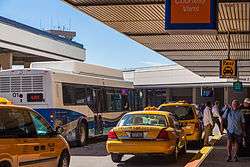
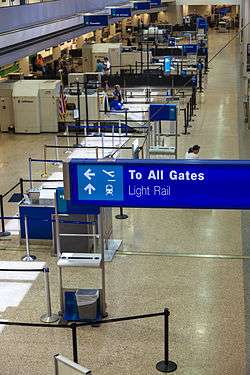

.jpg)
Top destinations
| Rank | Airport | Passengers | Carriers |
|---|---|---|---|
| 1 | Denver, Colorado | 782,000 | Delta, Frontier, Southwest, United |
| 2 | Los Angeles, California | 629,000 | Alaska, American, Delta, Southwest, United |
| 3 | Phoenix–Sky Harbor, Arizona | 619,000 | American, Delta, Frontier, Southwest, US Airways |
| 4 | Atlanta, Georgia | 514,000 | Delta, Frontier |
| 5 | Las Vegas, Nevada | 498,000 | Alaska, Delta, Frontier, Southwest |
| 6 | Seattle/Tacoma, Washington | 492,000 | Alaska, Delta |
| 7 | Dallas/Fort Worth, Texas | 420,000 | American, Delta |
| 8 | Portland, Oregon | 346,000 | Alaska, Delta |
| 9 | Chicago–O'Hare, Illinois | 332,000 | American, Delta, Frontier, United |
| 10 | San Francisco, California | 300,000 | Alaska, Delta, United |
| Rank | Airport | Passengers | Carriers |
|---|---|---|---|
| 1 | Paris (Charles de Gaulle), France | 128,252 | Delta |
| 2 | Vancouver, Canada | 70,918 | Delta |
| 3 | Calgary, Canada | 67,679 | Delta |
| 4 | San José del Cabo, México | 38,717 | Delta |
| 5 | Puerto Vallarta, México | 20,868 | Delta |
| 6 | Cancún, México | 20,222 | Delta |
| 7 | Guadalajara, México | 9,461 | Delta |
Other airport information
The airport spans over 7,700 acres (3,116 ha) and has four runways. The runways are generally oriented in a NNW/SSE magnetic direction due to consistent prevailing winds in this direction.
Cargo operations
The airport handled 156,319 metric tonnes of cargo in 2008.[37]
General aviation
Despite being the twenty-eighth busiest airport in the world in terms of aircraft operations,[8] the airport still maintains a large general aviation presence. In 2008, 19% of aircraft movements at the airport came from general aviation traffic.[37] This is in contrast to most large airports, which encourage general aviation aircraft to use smaller or less busy airports in order to prevent delays to commercial traffic. The airport is able to effectively handle both commercial and general aviation traffic largely in part to the airport's layout and airspace structure. Nearly all general aviation operations are conducted on the east side of the airport, away from commercial traffic. Additionally, smaller and relatively slower general aviation aircraft arrive and depart the airport in ways which generally do not hinder the normal flow of arriving or departing commercial aircraft.
2007 data shows there are 388 general aviation aircraft based at the airport.[2] The airport has only one Fixed-Base Operator, located on the east side of the airport which has been of debate between aircraft operators and the SLCDA. The airport has facilities for Air Ambulance, Law Enforcement, as well as state and federal government aircraft. Additionally, the airport is home to several flight training facilities, including one operated by Westminster College.
Military operations
The Utah Air National Guard operates Salt Lake City Air National Guard Base on the east side of the airport. In November 2014, the installation was renamed the Roland R. Wright Air National Guard Base after Brigadier General Roland R. Wright, USAF (Ret).[38]
The base occupies approximately 135 acres as a U.S. Government cantonment area leased from the airport. In addition to flight line, the installation comprises 63 buildings: 3 services, 13 administrative, and 47 industrial. There are 255 full-time Air Reserve Technician and Active Guard and Reserve personnel assigned, augmented by 1,343 part-time traditional air national guardsmen.
The host wing for the installation is the 151st Air Refueling Wing (151 ARW), an Air Mobility Command (AMC)-gained unit operating the KC-135R Stratotanker.
Airport facilities
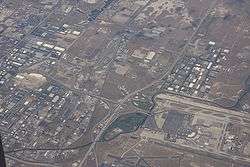
Wingpointe, an 18-hole golf course, is located on the south end of the airport.[39]
The airport has free Wi-Fi internet access.[40]
Delta Air Lines' Sky Club, located between concourses C and D, is the only lounge at this airport.[41]
Salt Lake City International also houses a hangar and line maintenance facility for Delta Air Lines' primary maintenance, repair and overhaul arm, Delta TechOps.[42] Delta also operates a call center for reservations and sales as well as regional corporate offices.
SkyWest Airlines opened a new maintenance and training facility at the airport in 2001 where the company has its largest maintenance base. It is also where training is conducted for pilots, flight attendants, and other employees.
United Airlines operates a call center located near the airport.
Boeing Aircraft Company operates a manufacturing plant at the airport which manufactures vertical stabilizers and horizontal stabilizers for the Boeing 787 as well as components for the Boeing 737.[43]
The airport and Salt Lake City Fire Department operate an Aircraft Rescue and Fire Fighting (ARFF) training facility located on the airport. The training facility has been used to train and certify thousands of fire fighters from departments all over the world, including Antarctica.
In addition to the 328-foot-tall (100 m) Air Traffic Control Tower, TRACON is also located on the airport with the Salt Lake Air Route Traffic Control Center (ARTCC) located adjacent to the airport. The Salt Lake ARTCC covers the largest geographical area in the continental United States and controls airspace as far north as the Canada–US border.[44]
Economic impact
Salt Lake City International airport is directly responsible for the employment of over 14,000 people and indirectly provides over 100,000 jobs generating a $2.7 billion payroll. The airport contributed a $5.34 billion economic impact in 2004.[5]
April 30, 2008 marked a significant date for the airport, as it became the only large hub airport in the U.S. to be debt free, having retired its remaining bonds, for a payout of nearly US$50 million. This was done in response to spiking interest rates, but also put the Salt Lake Department of Airports in a better financial position for future expansion plans.[11]
Airport expansion


A revised master plan was released in May 2006 for the airport and is available for the public to view at the airport's website. Future plans call for runway 17/35 to be realigned to more precisely parallel runways 16L/34R and 16R/34L. Plans also call for runway 16L/34R to be lengthened to 15,100 feet (4,600 m). Plans for a fourth parallel runway west of 16R/34L are also shown, but is more than fifteen years away.[45]
In addition to runway reconfigurations, the airport will construct a new terminal and two new concourses. Plans call for a single terminal with an attached concourse consisting of 31 mainline gates and an additional parallel satellite concourse consisting of 15 mainline gates and 44 regional jet gates. The two concourses would be attached with an underground automated train. The existing terminal and concourses would be demolished and would leave room for additional expansion onto the two new concourses in the future.
Other plans call for a new parking garage and expanded cargo facilities. Construction of the Airport extension of the Utah Transit Authority's (UTA) TRAX light rail system (Green Line) from Downtown Salt Lake City to the airport began in October 2008, and began service on April 14, 2013.[46][47] The TRAX Green Line connects the airport with the rest of UTA's rail system, including the FrontRunner (a commuter rail train that connects Salt Lake City with Ogden on the north and Provo on the south).[48] In addition to the rail network itself, the TRAX line also connects with Park and Ride lots of both TRAX and FrontRunner, which allow transit patrons to avoid having to pay for parking at the airport.[Note 1]
In June 2010, the airport asked for public comments on the airport expansion as well as announcing the start of an environmental study of the master plan which had public hearings in the summer of 2011.[50] In February 2012, the airport announced that construction would likely begin in 2013, with completion slated for 2022. The expansion's details are deliberately being kept flexible to better adapt to changing conditions in the airline industry and are likely to change over the next 8–10 years. A top priority of the expansion will be to greatly increase airport buildings' resistance to earthquakes.[51]
Access
Motor Vehicle
The airport is accessible from I-80 at exit 115 B or from I-215 at exits 22 and 22 B. The airport can also be accessed from North Temple street and Utah State Route 154 (Bangerter Highway) both of which terminate and merge into the airport's Terminal Drive.
Public Transit
Rail and bus services that connect the surrounding region to Salt Lake City International Airport include TRAX light rail, UTA Bus service and FrontRunner commuter rail (via UTA TRAX).
| Route | Destination | Service Times | Terminals Served | Schedule |
|---|---|---|---|---|
| UTA TRAX Light Rail Service | ||||
| Green Line (Route 704) | Light Rail service to North Temple Bridge, Temple Square Station, and City Center Station. Access to the 701 TRAX Blue Line (Draper), 703 TRAX Red Line (South Jordan and the University of Utah) and 750 FrontRunner (Ogden and Provo). | 5:40am to 11:30pm every 15 minutes on weekdays 6:30am to 11:15pm every 20 minutes on weekends |
Terminal 1 | [52] |
| UTA Bus Service | ||||
| Route 551 | Bus service to the west side of Salt Lake City. | Limited morning and afternoon service on weekdays | Terminal 1 | [53] |
| Route 453 | Bus service to Tooele, Utah. | Limited morning and afternoon service on weekdays | Terminal 1 | [54] |
| Route 454 | Bus service to Grantsville, Utah. | One morning and evening shuttle on weekdays | Terminal 1 | [55] |
Taxis, limousines and shuttle vehicles
Ground transportation is available to ski resorts and locations throughout Salt Lake, Davis, Weber, Utah and Summit counties from Salt Lake International Airport. Many Salt Lake taxis, limousines and shuttles accommodate ski equipment.
Accidents and incidents
- On November 11, 1965, United Airlines Flight 227, operated with a Boeing 727, crashed just short of the runway at Salt Lake City International Airport (then named Salt Lake City Municipal Airport), killing 43 of the 91 people on board.
- On December 3, 1974 a Frontier Airlines Boeing 737 flight, mistakenly landed at South Valley Regional Airport (then called the Salt Lake City Municipal Airport II [U42]), 4 miles (6.4 km) south of its intended destination at Salt Lake City International Airport.[56]
- On December 17, 1977, United Airlines Flight 2860, a cargo flight operated with a Douglas DC-8 crashed into a mountain near Kaysville while in a holding pattern prior to landing at Salt Lake City International Airport. The crew was trying to figure out an electrical problem, and did not realize they were adjacent to a mountain. All three people on board were killed in the accident.
- On August 31, 1988, Delta Air Lines Flight 1141, which was bound for Salt Lake City from Dallas-Fort Worth International Airport, crashed after takeoff. Two of seven crew members and twelve of 101 passengers were killed.
- On October 14, 1989, Delta Air Lines Flight 1554, operated with a Boeing 727, caught fire during the boarding process for a flight to Edmonton, Alberta, Canada while the aircraft was parked at a gate. Of the twenty-three people who were on the aircraft at the time, five sustained minor injuries. All passengers and crew evacuated, however the aircraft was destroyed. An investigation determined the fire started due to a malfunction with the passenger oxygen system.[57]
- On June 30, 2015, an Ameriflight Beechcraft Model 99 (Flight 1802) crashed immediately after takeoff on Salt Lake City International Airport's Runway 16L just before 8:00AM local time. Both pilots were reported uninjured. The flight was bound for Ely, Nevada.
- On November 17, 2015, an Air France Airbus A380 (Flight 65) en route from Los Angeles to Paris made an emergency landing at the airport following the November 2015 Paris attacks in Paris, France.[58]
In popular culture
The 1974 film Airport 1975 was filmed at Salt Lake City International Airport.[59]
In the 1994 comedy film Dumb and Dumber, Lloyd Christmas, portrayed by Jim Carrey, is seen running to gate B2 and falling off the jetway at Salt Lake City International Airport. He is also seen sliding across the floor to recover the brief case.[60]
The 2003 romantic comedy-drama film Latter Days featured a layover scene at Salt Lake City International Airport en route to Pocatello, Idaho, in which the main characters get stuck in Salt Lake City when a snow storm closes the airport.[61]
The airport was used for filming the scenes of the fictional Chicago Hoover International Airport in the 2006 film Unaccompanied Minors.[62]
See also
- Utah World War II Army Airfields
- South Valley Regional Airport
- Provo Municipal Airport
- Ogden-Hinckley Airport
Notes
- ↑ Recently the Utah Transit Authority (UTA) announced that beginning July 1, 2013 it will start a one year pilot program involving most of its TRAX and FrontRunner Park and Ride lots. The purpose of the new program is to make rider connections with the Salt Lake City International Airport more convenient by avoiding the need to park at the airport. The programs allows UTA patrons to park for an "unlimited amount of time" in the designated Park and Ride lots. In addition, UTA will allow free parking in all of its parking garages. Previous UTA policy limited parking to no more than 24 hours, except at its parking garages. As part of the year-long pilot program, "UTA will measure parking lot usage and monitor costs, maintenance requirements, impacts to snow removal and security issues before determining if the program will be extended." There are eight Park and Ride lots that are excluded from this test program and the 24-hour time limit will still apply to these lots. In addition none of UTA's bus Park and Ride lots are included in this program.[49]
References
![]() This article incorporates public domain material from the Air Force Historical Research Agency website http://www.afhra.af.mil/.
This article incorporates public domain material from the Air Force Historical Research Agency website http://www.afhra.af.mil/.
- ↑ http://www.slcairport.com/air-traffic-statistics.aspand
- 1 2 FAA Airport Master Record for SLC (Form 5010 PDF), effective February 24, 2009
- ↑ "Air Traffic Statistics". Salt Lake City International Airport. January 2016. Retrieved May 28, 2016.
- ↑ 2006 population estimates from the U.S. Census Bureau Retrieved on March 5, 2008.
- 1 2 "Utah Continuous Airport System Plan – Executive Summary". Utah Department of Transportation. Retrieved September 30, 2013.
- ↑ "AIR TRAFFIC STATISTICS AND ACTIVITY REPORT" (PDF). Salt Lake City Department of Airports. Retrieved April 14, 2014.
- 1 2 "Salt Lake City, UT: Salt Lake City International (SLC)". Bureau of Transportation Statistics, United States Department of Transportation. Retrieved January 24, 2011.
- 1 2 World's busiest airports by traffic movements
- ↑ "SLC Fast Facts". Salt Lake City Department of Airports. Retrieved April 16, 2013.
- ↑ "Department of Airports 2008–2009 budget" (PDF). Salt Lake City Corporation. Archived from the original (PDF) on June 9, 2011.
- 1 2 "Airport Retires Debt" (PDF) (Press release). Salt Lake City Department of Airports. April 30, 2008. Archived from the original (PDF) on March 4, 2009.
- ↑ "Curtiss Flies at Salt Lake". The New York Times. New York City. April 9, 1911. Retrieved March 4, 2008.
- 1 2 Wadley, Carma (December 4, 2003). "100 years of Flight". Deseret News. Salt Lake City: Deseret Digital Media. Retrieved March 4, 2008.
- 1 2 3 "Airport History". Salt Lake City Department of Airports. Retrieved April 16, 2013.
- ↑ Berryman, Marvin E. "A History of United Airlines". The United Airlines Historical Foundation. Retrieved April 16, 2013.
- ↑ The Ashton, Evans, and Brazier Papers
- ↑ "Airport History". Salt Lake City International Airport. Retrieved January 29, 2014.
- ↑ Mullins, Robert D.; Costanzo, Joe (August 12, 1977). "SL Airport Growing But How?". Deseret News. Retrieved June 16, 2012.
- ↑ "Salt Lake City International Airport Commuter Terminal and International Arrivals Building". GPA ARCHITECTS, INC. Retrieved September 30, 2013.
- ↑ "Walking path opens at Salt Lake airport". USA Today. The Associated Press. September 4, 2009. Retrieved April 16, 2013.
- ↑ Alberty, Erin (18 November 2015). "Air France plane diverted to SLC after bomb threat is cleared to leave for Paris". The Salt Lake Tribune. Retrieved 27 May 2016. C1 control character in
|title=at position 18 (help) - ↑ "Air Canada Unveils Major Expansion to 12 U.S. Destinations". Air Canada. November 19, 2015. Retrieved November 19, 2015.
- ↑ Hancock, Laura (June 4, 2009). "Delta begins nonstop flights between Tokyo, Salt Lake". Deseret News. Salt Lake City: Deseret Digital Media. Retrieved April 16, 2013.
- ↑ Beebe, Paul (May 7, 2010). "Delta to resume SLC-to-Tokyo route". The Salt Lake Tribune. Salt Lake City: MediaNews Group. Retrieved April 16, 2013.
- ↑ http://www.good4utah.com/story/d/story/delta-launches-new-service-from-salt-lake-city-to/30938/iODEIazcEUmxa0WSEYmcfQ
- ↑ "Delta to add second Europe route from Salt Lake City". USA Today. July 28, 2014. Retrieved July 30, 2014.
- ↑ "Delta to offer nonstop flights from Salt Lake City to London". Deseret News. August 25, 2015. Retrieved August 27, 2015.
- ↑ "KLM to launch service to Salt Lake City (USA) and Ibiza (Spain)". 15 December 2015. Retrieved 15 December 2015.
- ↑ Salt Lake City International Airport. "SLCA-Overview" (PDF). Retrieved 2015-04-23.
- ↑ https://thefloridasqueeze.com/2016/05/19/delta-add-fort-lauderdale-seattle-miami-salt-lake-city-nonstops-southern-florida-strategy-continues-to-be-confusing/
- ↑ http://news.delta.com/delta-adds-service-between-los-angeles-and-washington-reagan
- ↑ http://www.routesonline.com/news/38/airlineroute/267208/delta-resumes-salt-lake-city-aspen-route-from-dec-2016/
- 1 2 http://www.usatoday.com/story/travel/flights/todayinthesky/2016/10/13/southwest-grows-out-west-adds-two-salt-lake-city-california-routes/91984922/
- ↑ http://airlineroute.net/2016/04/17/ua-domestic-16h2/
- ↑ "Salt Lake City, UT: Salt Lake City International (SLC)". Bureau of Transportation Statistics, United States Department of Transportation. Retrieved November 24, 2016.
- ↑ "Salt Lake City, UT: Salt Lake City International (SLC)". United States Department of Transportation. May 2015.
- 1 2 "2008 Salt Lake City International Airport Statistics" (PDF). Salt Lake City Department of Airports. Retrieved February 24, 2009.
- ↑ "Utah Air National Guard Base renamed to honor 95-year-old hometown hero".
- ↑ "Wingpointe Golf Course". Salt Lake City Golf. Retrieved April 16, 2013.
- ↑ "Airport Services". Salt Lake City Department of Airports. Retrieved April 16, 2013.
- ↑ "Sky Club Locations". Delta Air Lines. Retrieved July 1, 2013.
- ↑ Jensen, David. "Delta TechOps Rejuvenated". Aviation Today. Retrieved June 13, 2013.
- ↑ Mckitrick, Cathy (March 16, 2012). "Boeing Dreamliner makes stop in Salt Lake City". The Salt Lake Tribune. Salt Lake City: MediaNews Group. Retrieved April 16, 2013.
- ↑ Image:Tfrmap.jpeg – Air Route Traffic Control Centers in the United States.
- ↑ "Salt Lake City International Airport: Airport Layout Plan Update" (PDF). HNTB Corporation. May 2006. Retrieved October 1, 2013.
- ↑ "Utah Transit Authority Airport TRAX line FAQs". Utah Transit Authority. Retrieved October 1, 2013.
- ↑ "Airport TRAX Line to Open April 14". Utah Transit Authority. October 24, 2012. Retrieved October 1, 2012.
- ↑ TRAX & FrontRunner Map (JPG) (Map). Utah Transit Authority. Aug 2013. Retrieved October 1, 2013.
- ↑ "UTA Offers Free Multi-Day Parking". Utah Transit Authority. June 26, 2013. Retrieved July 19, 2013.
- ↑ "SLC airport expansion plan open to comment". The Salt Lake Tribune. Salt Lake City: MediaNews Group. June 18, 2010. Retrieved April 16, 2013.
- ↑ Page, Jared (February 21, 2012). "Everything you wanted to know about the Salt Lake City International Airport expansion". Deseret News. Salt Lake City: Deseret Digital Media. Retrieved April 16, 2013.
- ↑ "Route 704 Green Line Schedule".
- ↑ "Route 551 International Center Schedule".
- ↑ "Route 453 Tooele–Salt Lake via Airport Schedule".
- ↑ "Route 454 Grantsville–Salt Lake via Airport Schedule".
- ↑ "737 lands at wrong airport". Deseret News. Salt Lake City. December 3, 1974. Retrieved April 16, 2013.
- ↑ NTSB report
- ↑ Marsh, Rene; Yan, Holly. "2 Air France flights from U.S. to Paris diverted because of bomb threats". CNN. Retrieved November 18, 2015.
- ↑ Libretio (October 18, 1974). "Airport 1975 (1974)". IMDb.
- ↑ "When Utah Was Dumber: Take a tour of Utah's most iconic Dumb & Dumber shot locations". Salt Lake City Weekly.
- ↑ "Latter Days (2003)". IMDb. July 1, 2004.
- ↑ Gary Dudenko (December 8, 2006). "Unaccompanied Minors (2006)". IMDb.
External links
| Wikimedia Commons has media related to Salt Lake City International Airport. |
- Official website
- FAA Airport Diagram (PDF), effective November 10, 2016
- FAA Terminal Procedures for SLC, effective November 10, 2016
- Resources for this airport:
- AirNav airport information for KSLC
- ASN accident history for SLC
- FlightAware airport information and live flight tracker
- NOAA/NWS latest weather observations
- SkyVector aeronautical chart for KSLC
- FAA current SLC delay information
